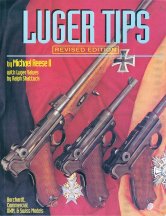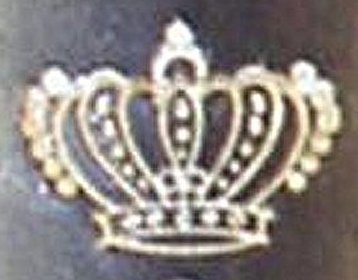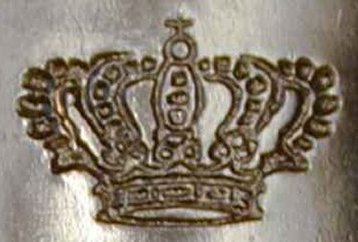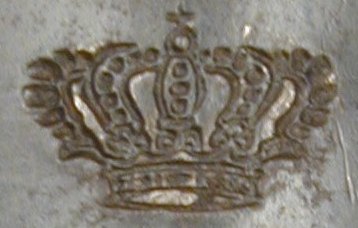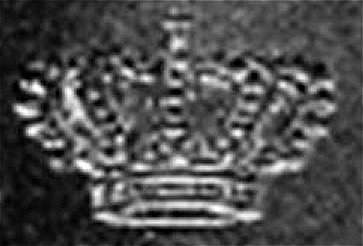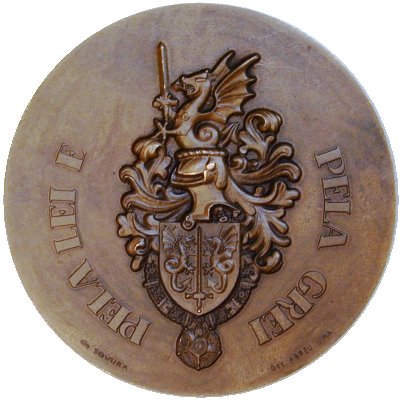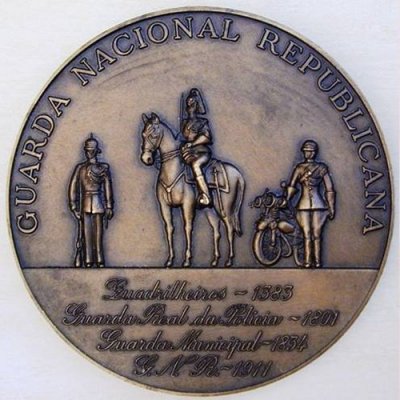buttons
Background
The association of the Portuguese military and the Luger covers almost 45 years from the early 1900s to 1943. The contract history has been covered extensively by every major Luger author. However, as in any history, the knowledge base can be expanded and challenged. This article deals mostly with the Portuguese navy and the Luger, of which previously published information are a bit out of date and tend to repeat the same original material presented 50 years ago. New information is presented to clarify and expand the knowledge base and some rare, previously unpublished Portuguese navy Luger variations, known only to a few, are illustrated and discussed.
Certain specific detailed comparisons, comments, and theories are put forth and presented with supporting rational in this article in text and pictures with the intent to point out differences. The purpose of these comments and comparisons of gun examples and previously published information cited are not to make declarations of right or wrong, correct or incorrect, but simply to point out those differences. Readers are left to agree or disagree, i.e. to reach their own conclusions.
The Contract
Pistola Parabellum da Marinha Portuguêsa Mo.910
1910 delivery of Mo.910 chamber crested Royal Portuguese crown over fouled anchor: 350 pistols, 1 to 350.
1912 delivery of Mo.910 chamber crested R.P. (Republica Portuguêsa) over fouled anchor: 300 pistols, 351 to 650.
Note that the above downward revised delivery schedule is based on a review of the actual 23 November 1909 Portuguese contract to DWM, presented herein, and the lack of authenticated identified guns above 650. All previously published delivery totals were for 1,000 Mo.910 contract Portuguese Navy Lugers.
Other features unique to the model 1906 grip safety Portuguese Navy Lugers other than the chamber crests are the CARREGADA marked extractors and an MP or Marinha Portuguêsa (Portuguese Navy) monogram, located on the receiver left side, observed on serial numbers up to about 500.
In September 1997 F.G.S., Inc., owned by a major, very reputable Luger collector and dealer, purchased a large batch of Portuguese Navy Lugers from the Portuguese Navy arsenal in Lisbon, Portugal, through an intermediary, identified as INDEP1. The quantity purchased was 367, which is staggering. The purchase was known only to a few serious Luger collectors and some dealers.
Prior to the 1997 purchase, efforts were underway by serious Luger collectors to garner more information about the purchase history of the Portuguese Navy Luger. Through these efforts, the initial November 1909-dated Portuguese 350 gun, "hand written" contract order for the purchase of the Model 1910 or Mo.910 as designated by the Portuguese Navy, was identified. Some actual 1912 dated Deutsch Waffen und Munitionsfabriken, a.k.a. DWM letterhead delivery invoices, representing the final 150 R.P. over fouled anchor chamber crested Luger order contained specific information regarding accessories, ordered and delivered, detailed to the point of describing the delivery packaging details were also identified. As part of a separate set of identified paperwork originating from DWM and represented by the firm of Henri Burnay & Cie2 to the Portuguese in 1912 were the shooting test results on the last 150 contract delivery of R.P. Navy Lugers. All of this information was made available to F.G.S., Inc. The paperwork has been known or made available to a few serious collectors for many years as the Portuguese contract information presented herein shows evidence of being copied many times.
The text of the documents are hand-written in the Portuguese language. Certain key sections that were germane to the contract were translated. The writing is very stylized and could well be period. However, it is not certain whether the paperwork is a copy of the original contract or simply a modern day, hand-written translation of the original by another individual. Nevertheless, the information is deemed authentic. The following "fragmented" best-effort English translation was also located on the material:
|
On the 23rd of the month of November 1909 in the first branch of the General Directorate of the Navy in the presence of the administrative council of the same branch, composed of commander xxx, Lt commander xxx, 2nd Lt. xxx, contractor DWM represented by Henry Burnay,3 resident of No. 10 Princia St., Lisbon, persons whose identity was legally recognized, vouch for the present terms of the contract definitely, for the provision of 350 automatic pistols, "Parabellum" (systema Borchardt Luger) short model 9 m/m caliber and of 20 thousand cartridges, loaded with smokeless powder for these pistols., 350 holsters in black leather, 350 pouches for two magazines and 350 leather lanyards for said pistols.
The government of Portugal orders from Deutsche Waffen und Munitionsfabriken: |
Pictured below is the actual last paragraph of the document which shows evidence of being copied many times:

Correspondence dated February 5, 1912
The following is a translated letter to the Portuguese Navy's war materials directorate from Navy headquarters General Directorate:
Á Direccto á Materiel de Guerra de Marinh
Referencia a nota no 38, 5-2-1912
- For your convenience herewith are the results of the tests which were subjected to the 150 pistols requested in requisition 5-2-1912, No 13 which accompanied the above referenced note, and which (the pistols) have just been received in the warehouse of that Directorate. Attached is also provided a breakdown of the contents of the shipping boxes and copies of the respective (German:English) invoices.*
|
Herren Henry B u r n a y & C i a.
L i s s a b o n. S p e z i f i k a t i o n. ------------------------------ 6 Kisten mit Zinkeinsatz gezeichnet Direccao Geral de Marinha, Lisbonne No. 1395/1400 Hamburg - Ausfuhrgut Gewicht jeder Kiste: Brutto 63. – kg Netto 38. – kg Maasse jeder Kiste: 870 x 420 x 370 mm Enthaltend: 150 Parabellum-Pistolen Cal. 9 mm mit je 3 reser > veladeranmen und je 1 Satz Zubehör 150 schwarze Ledertaschen mit Magazintaschchen und Kordelschnur, sowie Reimen. ----------------------------- 4 Kisten mit Zinkeinsatz gezetichnet Direccao Geral de Marihna, Lisbonne No. 1401/1404 Hamburg - Ausfuhrgut Gewicht jeder Kiste: Brutto 70. – kg Netto 63 – kg Maasse jeder Kiste: 560 x 260 x 210 mm Enthaltend: 20,000 Patronen zur Parabellum-Pistole Cal. 9 mm mit Flachspitzgeschessen. ----------------------------- 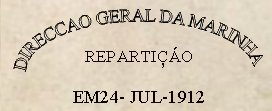 |
| German invoice. |
|
Herren Henry B u r n a y & C i a.
L i s b o n. S p e c i f i c a t i o n. ------------------------------ 6 boxes with zinc lining with markings General Directorate of the Navy, Lisbon No. 1395/1400 Hamburg - Ausfuhrgut Weight of each box: Gross 63. – kg Net 38. – kg Dimensions of each box: 870 x 420 x 370 mm Contents: 150 Parabellum-Pistolen Cal. 9 mm reserve magazines and 1 set of tools 150 Black Leather holsters with magazine pouch and lanyard, also belts. ----------------------------- 4 boxes with zinc lining with markings General Directorate of the Navy, Lisbon No. 1401/1404 Hamburg - Ausfuhrgut Weight of each box: Gross 70. – kg Net 63 – kg Dimensions of each box: 560 x 260 x 210 mm Contents: 20,000 cartridges for Parabellum-Pistol Cal. 9 mm with truncated bullets. -----------------------------  |
| English translation of German invoice. |
Shown below is one typical page of the test results mentioned is the preceding letter. The page and letterhead illustrate some of the last batch of 150 test fired R.P.-over Anchor chamber crested Lugers, numbered 501-650, delivered in February 1912. There are six pages with Roman numerals I through VI. The first column is numbered 1 through 150; however, there is no apparent order. The gun serial numbers are not listed chronologically but are randomly presented with No. 1 being serial number 647 and No. 150 being serial number 506. All serial numbers are identified, starting from 501, being No 49 on page II and 650 being, ironically also on page II, as No. 27.
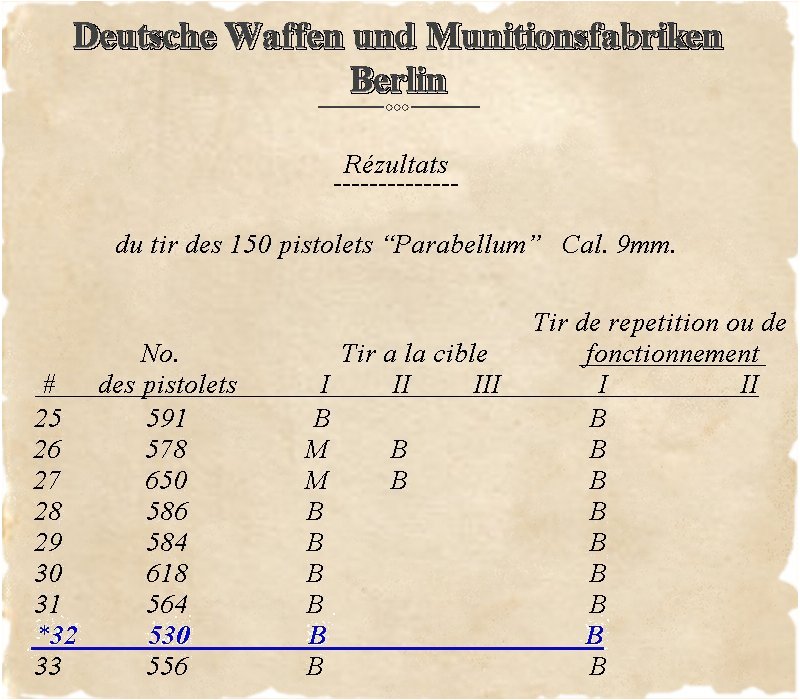
| ||||||
| Legend: | ||||||
| B = good - passed | ||||||
| M = bad – failed | ||||||
Luger Literature Review of Portuguese Navy Luger Contracts
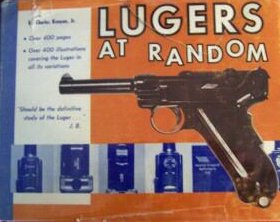 Excerpt from page 132 and 136. |
In Lugers at Random, Kenyon (1968) states the following on page 132 about the Portuguese Navy contract royal crown-over-fouled-anchor chamber crested Luger. |
 Excerpt from pages 231-232. |
In The Luger Book, J. Walters (1986, pages 231-232) expands on Kenyon’s description in Lugers At Random: (ii) The Navy Mo.910 The purchase of army (M2 chamber crested, 120mm barrel length, 30 Cal) Parabellums encouraged the Navy to follow suit, though the latter selected 9mm caliber and 10cm barrels. A contract for a mere 1,000 with DWM late in 1909 – the Navy, after all, was quite small – and the first 'Pistola Luger-Parabellum da Marinha Portuguesa Mo.910' was delivered early in 1910. But only about 800 had been delivered by 5 October when a revolution put the king to flight. DWM hastily changed the style of the chamber mark and delivered approximately 200 of the so-called 'Republican Model' in which R.P. (Republica Portuguêsa) replaced the crown in the original crown-and-anchor chamber mark. The highest reported number on a 'royal' pistol is 769; for a republican, 993. Instead of the encircled triangle property mark, Navy guns displayed an 'MP' monogram – Marinha Portuguêsa, or Portuguese Navy. |
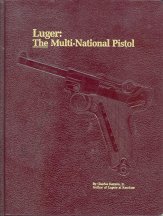 Excerpt from page 112. |
In Luger: The Multi-National Pistol, Kenyon (1991) states on page 112, in a text description entitled: Model 1906 Portuguese Navy basically quotes J. Walter in The Luger Book, repeating the 1,000 order information and the 800 delivery interruption, although he doesn’t mention individual serial number examples as does Walters. Immediately following the 1909 Portuguese Army purchase, the Portuguese Navy placed an order for 1,000 Model 1906 Lugers (4" barrels, Cal. 9mm) in late 1909 the official Portuguese designation being Mo. 1909. The (fine) example portrayed here (variation 1, opposite page) is of this group. DWM had supplied about 800 of the pistols when the Monarchy of King Manuel II was overthrown and the Republic of Portugal was installed. A new chamber marking was quickly implemented replacing the crown/anchor emblem with an R.P./anchor emblem. These Portuguese naval pistols exhibit the word "Carregada" on the left side of the new style extractor and bear a stylized "MP" standing for "Marinha Portuguesa" far forward on the left side of the receiver (variation 1). |
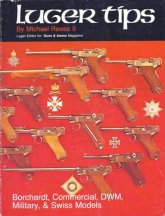 Original 1976 edition
|
Michael Reese, curiously, does not mention the 1906 Portuguese Navy variation, nor any Portuguese contract Lugers is his original 1976, Volume 1 publication of "Luger Tips". But his 1992 "Revised Edition" of Luger Tips does cover the Navy variation extensively on page 48, however, he only discusses the variation 1 Royal Crown-over-fouled-anchor with no mention of the R.P. variation 2, unusual, seeing that both variations were first identified and described in 1968 in Lugers at Random on pages 132 and 136. The following are excerpts from the 1992 publication "Luger Tips": This model is quite rare being second only to the Russian contract. The author has seen only one example and has never seen one for sale anywhere. The contract was for 1000 pistols, the minimum order DWM would accept on a foreign government contract…The highest serial number reported is 769. Michael Reese describes on page 50 the 1909 Royal Portuguese Army M2 contract: There are several M IIs in collectors' hands today; however the Navy model is much harder to find, as it is the author's understanding that the Portuguese government still has most of these (Navy) models in their arsenal. Apparently, Michael Reese was quite accurate in the disposition of the Portuguese Navy Mo.909 Lugers being stored, also suggesting that, early on, the Portuguese Navy arsenal was visited by (raided) dealers and/or collectors prior to the 1997 F.G.S., Inc. acquisition. |
The Portuguese Navy Luger serial number 769 was first identified in 1968 in Lugers at Random by Kenyon as the highest known Portuguese Royal Navy Luger. Serial number 769 reappeared in Luger publications in 1986. Walter, in "The Luger Story" added serial number 993 implying or supporting the contention of an initial (interrupted at 800 by the revolution) 1000 gun order. No authenticated example of either crested variation above or immediately below serial number 769 crown-over-fouled-anchor or serial number 993 R.P. crest has been identified or detailed in a publication since 1968. There also is no published DWM source data to support the 1000 minimum order DWM policy. Apparently, there was no such policy in place with Mauser as foreign government contracts of less than 100 were accepted.
The cited July 1912 invoice data shows delivery of, one has to assume, the second and final lot of 150 R.P.-over-fouled-anchor chamber crested Portuguese Navy Lugers serial numbers 501 to 650. The definitive, initial stand-alone October 1909 contract order for 350 was for delivery of, no doubt, the royal crown-over-fouled-anchor chamber crested pistols serial numbered 1 to 350. This order history pretty much debunks any previous claims of a 1,000 initial pistol order. The specifics of the order of pistols numbered from 351 to 500 is not known, but there is no doubt that this lot order was placed by the new Portuguese Republic after King Manuel II was deposed, sometime after October 1910. Presumably, those Lugers would have the R.P.-over-fouled-anchor chamber crest.
Most of the identified Portuguese Navy Lugers delivered up to serial number 500 are stamped on the receiver left side with the MP monogram Marinha Portuguêsa or Portuguese Navy property mark. Those after lack the property mark and may represent a policy change of the new government and/or the Navy. This theory is not absolute as some R.P. anchor guns have been identified with what appears to be the MP Navy property mark. The change is further complicated by the last, very well documented late 1912, 150 pistol delivery with DWM test results presented herein. Some pistols failed certain tests as shown on the test results page above, yet were accepted by the Portuguese (Navy) officials with the entire batch lacking the MP mark. Apparently, the MP mark, whether present or not, does not represent any form of acceptance and is indeed solely used as a property mark.
The F.G.S. Inc. Portuguese Navy arsenal Lugers
As stated in the beginning of this article, it is known to a few serious Luger collectors and some dealers that in September 1997 F.G.S., Inc., purchased a large batch of Portuguese Navy Lugers, specifically 367, from the Portuguese Navy arsenal in Lisbon, Portugal, through an intermediary, identified as INDEP4. About one hundred of the 367 guns are some of the approximately four thousand guns acquired by the Portuguese military in 1943 are 41 byf marked Lugers or Pistolas Parabellum do Exercité Português Mo.943. It is not unusual to find these guns in the Navy arsenal as some were allocated to the Portuguese Navy.
What is unusual is that about twenty of the 367 guns were a mix of 1920 DWM commercials and WW1 guns for a total of 120 non-Portuguese navy Lugers. The balance of approximately 247 Lugers consisted of a combination crown-over-fouled-anchor and R.P.-over-fouled-anchor 1910 contract Lugers with matched and mismatched examples. The remainder of the batch were of a few 1935/06 Mauser Banner c/c/U proofed Portuguese Navy contract grip safety Lugers and a couple of 41 chamber dated Mauser Banners and a single 42 Mauser Banner commercial "Portuguese Navy" Luger. Since 1997 about fifty of the original 367 Lugers have been sold.
Assuming that 200 of these guns are 1910 contract Portuguese Navy Lugers, then F.G.S., Inc. had, at the time, acquired approximately 30% of all DWM contract Portuguese Mo.910 navy Lugers manufactured. Also the range of serial numbers identified in the arsenal acquisition start from single digits to serial numbers above 500 and pretty much represents the established contract range of 1 to 650. F.G.S., Inc., to this day, is very reluctant to release the exact or specific list of serial numbers, although per conversations with F.G.S. Inc., serial number 1 was part of the acquisition. Starting with a total of 650 guns (350 crown and 300 R.P. guns) in the Portuguese contract, the following scenario is presented for the 200 FGS Inc. acquisition of 108 crown-over-anchor (Variation 1) and 92 R.P.-over-fouled-anchor (Variation 2) chamber crests Navy Lugers.
Assuming 25% of the FGS Inc. Variation 1 and Variation 2 guns are mismatched arsenal assembly guns, then the number of matched serial numbered collectible guns of varying conditions, from poor to good is significantly reduced. Therefore, there would be 81 matched Variation 1 and 69 Variation 2 guns in the FGS Inc. inventory, still a huge amount in a single collection.
| Chamber crest | FGS Inc. | FGS Inc. | Percent | Order |
| Totals | Matched | Matched | total | |
| Crown-over-fouled-anchor | 108 | 81 | 54% | 350 |
| R.P.-over-fouled-anchor | 92 | 69 | 46% | 300 |
| Summary | 200 | 150 | 100% | 650 |
It has been rumored that when the Portuguese monarchy, under King Manuel II (M2), was deposed and the monarchy replaced with a republic, the Portuguese Navy was allowed to keep their Royal crown-over-fouled-anchor guns. According to unsubstantiated reports, many of these guns were defaced, i.e., the crown on the chamber crest was removed, probably by republican loyalists. The same scenario may apply to the later delivered R.P.-over-fouled-anchor guns, this time at the hands of disgruntled monarchists. This type of scenario would not change the original production ratio.
Since very few of the F.G.S., Inc. guns have been sold, the few remaining Portuguese Navy Lugers on the market represent the surviving balance of the contract guns that were not of the F.G.S. 1997 acquisition. With the Mo.910 or Model 1910 Portuguese Navy Luger series being a very desirable collectible, it is a natural target of the mechanics. Many of these guns, whether arsenal mismatched or matched assemblies, are in poor condition.
On the worst of these guns, given the condition of the frame, especially the grip straps, the tendency of the mechanic is to replace the frame with readily available, relatively speaking, better condition commercial short frame grip safety example frames with a polished bright thumb safety area manufactured from 1906 to WW1. The only changes required would be to change the frame and barrel serial number and some cases not even that.
The collector who encounters any Portuguese Navy Luger in 90% or better condition should carefully inspect the gun - specifically the Mo.910 DWM contract gun - for correctness. Portuguese Navy Lugers when identified, having a 90% or better condition should be suspect. The top of the gun could be original, but the only way to verify authenticity, other than a thorough knowledge of finish and serial number font irregularities, is by internally located factory inspection marks, chronologically unique to the variation. An example of an internal factory inspection mark that is common to the 1909/12 Portuguese Navy contract(s) range and other DWM period commercial guns is located on the Carregada stamped extractor underside, and in this case also indicates the single-batch nature of the contract. This does not include the much lesser encountered 1935/06 Mauser Banner, short frame grip safety, v suffix serial number Portuguese Navy Lugers nor the 41 or the 42 chamber stamped P.08 no-grip safety Portuguese Navy Lugers, which are the least encountered.
The chamber roll die applied crests on both Mo.910 Portuguese Navy Luger variations, the Royal Portuguese crown-over-fouled-anchor and the R.P.-over-fouled-anchor share the same style fouled anchor, which simply is a generic style anchor depicted with what is supposed to be a rope or chain wrapped around the anchor as in "fouled." All observed/authenticated Portuguese Navy Luger chamber crested "fouled" anchor crests in the established first crown-over-fouled-anchor contract range of 1 to 350 are essentially identical. All the R.P.-over-fouled-anchor crests of the 1912 contract range of 351 to 650 deliveries are identical as well. Specifics of the anchor design are:
- The rope or chain is pictured wrapped around the anchor, without any striations5 that would indicate a braided/twisted rope or chain links.
- The horizontal bar at the top of the anchor, just below the eye, is shaped like a boat, curved on the bottom and straight on the top and is divided with four vertical bars, creating five sections. Within the larger center section are three horizontal lines, and within the smaller, less defined, divided sections on each side of the center section, are what look to be two horizontal lines.
The crown design is totally Portuguese, being very similar to the crown depicted on a 1910-dated 100 REIS Portuguese coin that features King Manuel II on the front side of the coin and the Royal Portuguese crown on the reverse. The two-dimensional crown design shows five curved or arched sections with points depicting jewels placed completely around, to the top center point, just below the orb and cross, and down to the lower head band. Note the jewels or points on all the five shown divisions of the crown arch over horizontally to the center of the crown.
Pictured and labeled are two Portuguese Navy Luger chamber crests, the first being a Royal-crown-over-fouled anchor, serial number 427 and an R.P. over fouled anchor, serial number 224. These are compared against Portuguese Navy Luger Royal crown-over-fouled-anchor chamber crest serial number 57, also labeled. The fouled anchor of serial numbers 427 and 224 are different from each other and different from 57. Also, 427 and 224 are different from each other. One has equally spaced striations in the fouled rope or chain, wrapped around the anchor, and the other doesn't. Both serial numbers 427 and 224 appear to lack the horizontal lines in the enclosed horizontal bar, just below the eye. The Portuguese Royal crown of 427 lacks any arched or horizontally placed jewels or points on top of the crown. Even though very small, these rope/chain striations and the horizontal lines in the enclosed horizontal bar, just below the eye should show or be visible on all Portuguese navy Luger chamber crested anchors, with or without white fill-in. There are other characteristics or differences of the rope or chain wrapped around the anchor and the in the R.P. stamping above the anchor in the examples shown, but not discussed.
Regarding the crown, one might expect to see minor differences in individual roll die stamped chamber crests, such as uneven applications resulting in lighter or heavier areas, missing or slightly deformed areas of the crest due to wear of the roll die or deterioration of the chamber crest from wear and tear. However, the crown of serial number 427 is of an entirely different design than the crown on other authenticated Portuguese Navy Lugers of which several examples are shown here: Example 1, example 2, example 3.
Confounding matters, the serial numbers of 427 for a Royal crown-over-fouled-anchor crest are above the recognized range of 1 to 350, and the 224 serial number is extremely low, i.e., out of the 351 to 650 range for an R.P.-over-fouled-anchor Portuguese Navy Luger. Pictured is a fairly accurate line drawing depiction of the crown of actual observed and authenticated Portuguese Navy crown-over-fouled-anchor chamber crest.
Land of Borchardt Collection
Pictured below are four Portuguese Navy Luger model variations, originally obtained from the F.G.S. Inc. 1997 Portuguese Navy arsenal batch acquisition of Portuguese Navy Lugers. All four Portuguese Navy Lugers pictured show typical hard use, yet are in relatively good condition. All have matching serial numbers and proper matching magazines, being obtained directly from the Portuguese Navy arsenal in Lisbon in 1997, becoming part of the F.G.S. Inc. inventory. As such their provenance is impeccable.
The first Portuguese Navy Luger model variation is a Mo.910 crown-over-fouled-anchor chamber crested, very low two digit serial number 57, first-lot contract-delivery Portuguese Navy Luger.

The receiver is property stamped with the MP or Marinha Portuguêsa monogram on the left side. The chamber crest is deeply stamped and well defined. The extractor is Carregada stamped using very small font characters and the lower, originally polished bright frame thumb safety area is unmarked. Coincidently, the Carregada font style and size of the model 1906 grip safety Portuguese Navy Luger are identical to the Carregada stamped extractor used in the model 1906 grip safety Brazilian Luger. The condition of the gun is exactly as it should be for a 100-year old Luger that saw hard use in the Portuguese Navy and subsequent long-term Navy arsenal storage.
Kenyon is the first Luger author and collector that asserts in Lugers at Random on page 136 under GENERAL NOTES: that the fouled-anchor chamber crest of the variation 2 R.P.-over-fouled-anchor Portuguese navy Luger, that the anchor was applied or positioned higher from the breech or chamber face than the variation 1 royal crown-over-fouled-anchor chamber crest. This cannot verified by LOB variation 1, serial number 53 and variation 2, serial number 530 as both fouled-anchors are applied identically, both being positioned or roll die applied 4mm from the breech or chamber face.
Pictured side-by-side, correctly dimensioned, are the R.P. chamber crests of serial number 530 and serial number 760 with the fouled-anchor serial number 760, actually the entire crest including the R.P. characters, being positioned 5mm from the breech or chamber face vs. the 4mm position of the R.P. and fouled-anchor crest of serial number 530, a 1mm difference. However, the chamber crest of 730, being of dubious authenticity is not a reliable benchmark, looking more like an engraving than a roll die. Since Kenyon as stated above, asserts on page 136 that variation 2 starts at serial number 800 and above, one has to assume the R.P.-over-fouled-anchor chamber crested gun Kenyon has pictured, opposite on page 137 is above serial number 800 with, as Kenyon states in his descriptive text, the anchor should be positioned higher from the breech or chamber face except, interestingly the Kenyon R.P.-over-fouled-anchor chamber crest is not higher, but is positioned identical to serial numbers 530 and 57. Also the Kenyon R.P. gun in Lugers At Random is the only published R.P. with what appears to be the MP or Marinha Portuguêsa navy property logo on the receiver left side.
All authenticated variation 1 royal crown-over-fouled-anchor crests serial numbers 350 and under and all variation 2 R.P.-over-fouled-anchor chamber crested guns serial numbered under 650 that were measured and featured in this article have the bottom of the anchor positioned or applied the same 4mm distance from the breech or chamber face.
1906/10 Portuguese Navy Luger Mo.910, variation 1
Royal Crown over Fouled Anchor
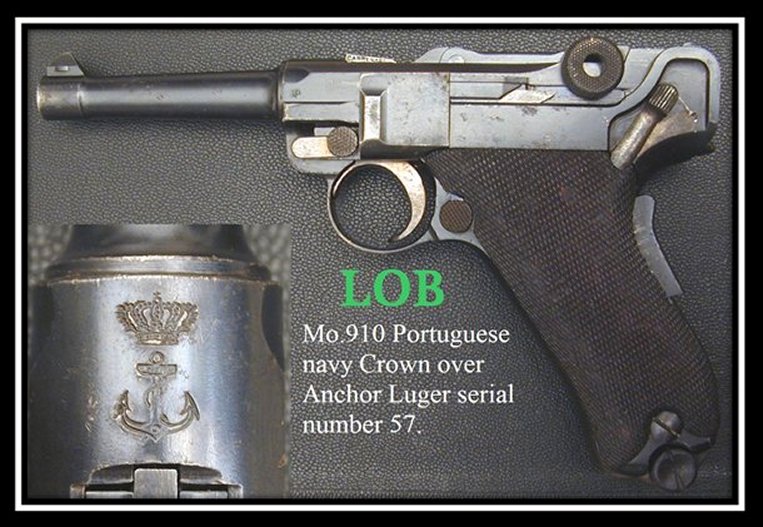
The second gun, serial number 530 contract Portuguese Navy Luger, is a receiver chamber crested R.P.-over-fouled-anchor in the high end contract serial number range and is in essentially the same condition as serial number 57.

Serial number 530, delivered as part of the last batch or lot of 150 R.P. anchor guns, lacks the MP monogram and is specifically one of the guns listed in the DWM table of in-house test results accompanying the shipment. Both the crown-over-anchor and R.P. Navy Lugers came with Cal. 9 m/m marked wooden bottom magazines. The magazine body of both magazines show wear, commensurate being with the guns from the original deliveries, strongly supporting the contention that all Mo.910 contract Navy Lugers were delivered with Cal. 9 m/m marked magazines.
1906/10 Portuguese Navy Luger Mo.910, variation 2
R.P. over Fouled Anchor
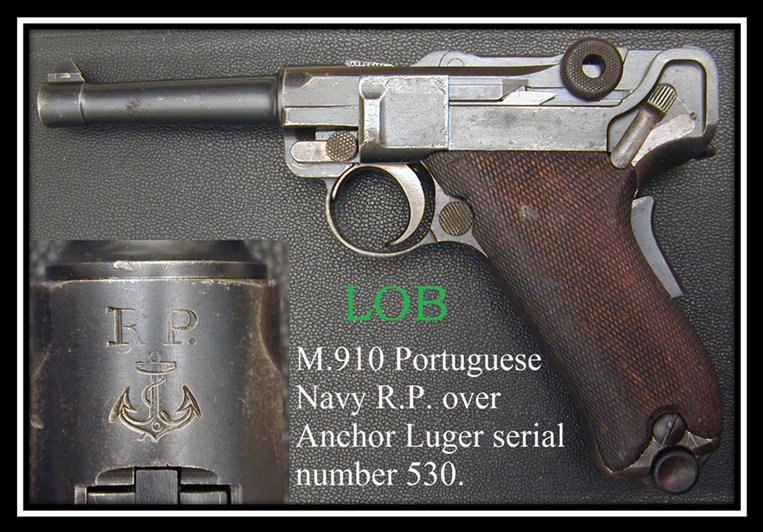
Some collectors believe that the crown found on the crown-over-anchor Royal Portuguese Navy chamber crest was removed by machining, possibly by DWM, of guns already manufactured with the monarchy chamber crest of the second and third lot R.P.-over-anchor chamber crest deliveries. However, that is not the case with serial number 530. The fouled anchor is the same style as the earlier crown-over-anchor guns except the proportions have changed slightly. For example, the left and right hooks on the lower curved section of the anchor are slightly larger. Also, the anchor is strongly stamped at the bottom and lightly stamped at the top. The R of the R.P. lacks the dot or period after the R which should be located just above the top of the anchor. As previously mentioned, the anchor is lightly stamped at the top as are the R. P. characters above the anchor. The R.P. characters however, are stylized and perfectly aligned left to right, indicative of a roll die application as opposed to being individually hand stamped.
DWM probably modified the existing crown-over-fouled-anchor roll die, by removing the royal crown and replacing it with the new R.P. characters. The new roll die appears to have a slightly different proportioned fouled anchor as viewed from the few stampings observed, but the effect was probably due to variations in the application.
Even if a crown-over-fouled-anchor chamber crest is identified with the crown being removed by defacing the chamber surface, it was more likely done by a republican royalist and not by DWM, especially if the serial number is below 350. Also with the last 150-lot delivery of R.P.-over-fouled-anchor Lugers being in early 1912, DWM had plenty of time to implement the new Portuguese government request to modify the crest.
The third pistol is a rarely encountered 1906/35 contract Portuguese Navy Mauser Banner grip safety Luger, serial number 2545v, being part of a very small, unidentified delivery amount Portuguese Navy contract order placed with Mauser in the mid 1930s.

This particular model, ironically, was first identified in The Luger Pistol, 1962 revision, by Fred A. Datig on page 285. While discussing the Mauser GNR contract, either he incorrectly identifies the chamber monogram as CMR or it could have been a printer's mistake. Interestingly this misidentification is addressed in a 1980s gun ad for Portuguese GNR and M2 Lugers where it states: Author Fred Datig was told in Germany that the model bears the insignia "C.M.R." entwined. The insignia actually is "G.N.R." and stands, we now learn, for the GUARDIA NATIONALE REPUBLICA. This, then is actually an army weapon (not navy as previously believed) and was purchased for the Republican National Guard. In 1962 Datig does correctly identify the 1906 Portuguese army M2 contract, the 1935 Mauser Portuguese 564 gun contract, except for the chamber crest and 70 gun 9 m/m contract orders. However, there is no mention of the 1909 DWM/Portuguese navy contract. The following are excerpts from The Luger Pistol discussing the 70 gun order: At the same time an order was placed for 70 Lugers of what Mauser refers to as the "normal" (P.08) type. These were of 9 m/m with 4 inch barrels and also employed the extractor marking of "CARREGADA" and with the frame beneath the thumb safety marked "SEGURANCA." They did NOT carry the "CMR" (or any other marking) over the chamber….No examples of either type the 7.65 m/m or the 9 m/m type Portuguese contract order of 1935 have been encountered and it is presumed that they are all still in service in that country….While both would be considered rare and the 7.65 m/m complete with the GNR marking most desirable, the 9 m/m type should be placed among the rarer variations of Luger pistols due to the small quantity produced. It wasn’t until 1986, 24 years later, that the (September) 1935 70 gun Mauser/Portuguese contract order was addressed by John Walters in The Luger Book on page 232 and even then the 70 gun order was still not identified or connected with the Portuguese navy.
1906/35 Mauser Banner grip safety Portuguese navy Luger
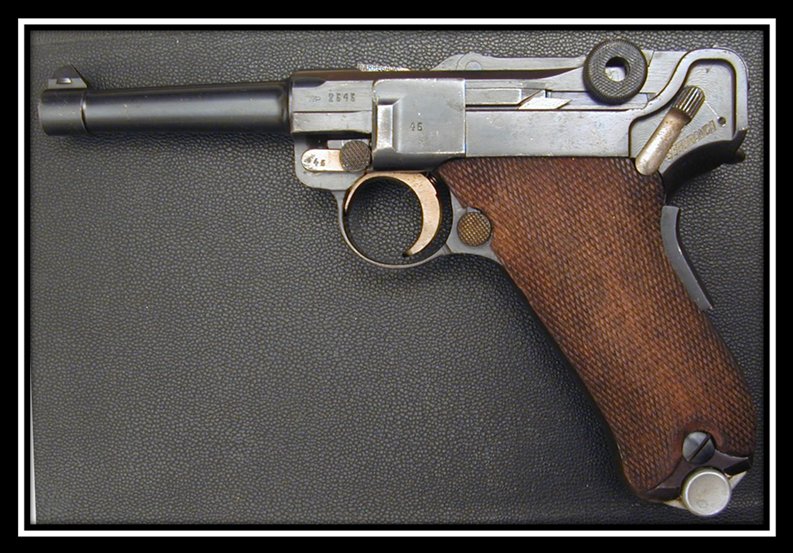
All serial numbers on this third pistol are matching, including a matching serial number aluminum bottom magazine that lacks the v suffix. The receiver, breechblock and barrel are clearly stamped with the horizontally placed, small size, Mauser double crown U commercial proof. The middle toggle link is stamped with the small Mauser Banner logo. The extractor is stamped CARREGADA in a large, highly visible font size, which is considerably larger than the rather small Carregada, single-stamped extractor found on the Mo.910 contract Lugers. The thumb safety area in the lower position is stamped SEGURANCA.
The 1906/35 G.N.R. (Republican National Guard) or Mo.935, is a model number assigned by authors and collectors, however, the only model ever assigned and recognized by the Portuguese is the original Mo.910, sort of like the P.08 for Germany. The pistol is known to the G.N.R. simply as A Pistola "PARABELLUM" or The Pistol "Parabellum" as indicated by the cover title of a very rare, recently identified 1941 dated Portuguese G. N. R. instruction manual, not shown but described on the cover page as:
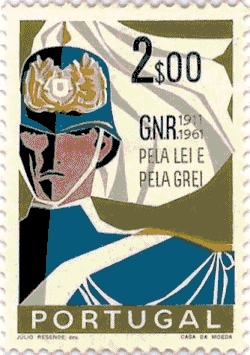
|
A Pistola "PARABELLUM" Caderno N.° 2 ========= 1941 ========= Edicao do Comando Geral da Guardia Nacional Republicana translation Notebook No. 2 - 1941 edition of the general command of the Republican National Guard. |
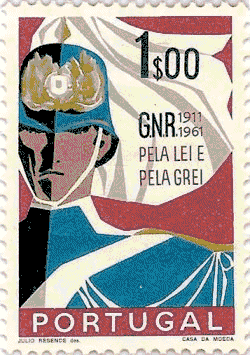
|
Apparently the GNR was held in high regard by Portugal, at least in 1962 as evidenced by the pictured, rather large, in color GNR embossed logo with the caption: Primeiro dia de circulação – Correio de Portugal meaning The first day of circulation by Correio of Portugal, being on the front of a 1962 specially designed Portuguese postal envelope issued 20-FEV-1962 - PORTO CTY commemorating the 50 year anniversary CINQUENTENÁRIO DA GUARDA NACIONAL REPUBLICANA 1911 – 1961 of the GNR with three very colorful Portuguese GNR commemorative postage stamps and a special designed, official postal GNR cancellation stamp in three places on the front. The back of the envelope has a very stylized, embossed circular logo of the printer or company CORRIEO DE PORTUGAL. Several distinct medallions were coined commemorating the Republican National Guard at various times. Pictured are two such examples. One was minted in 1971 celebrating the 60th anniversary of the GNR and the other was minted in 1973.
Front of medal: For the Law And For the People
Reverse side of medal: Commemoration Planning Heraldry (coat of arms) of the Republican National Guard
February 24, 1973
Republican National Guard
FRONT:
Guardrilheiros ~ 1383
Police Royal Guard ~ 1801
Municipal Guard ~ 1834
G.N.R. ~ 1911
1911 ~ 1971
SIXTIETH ANNIVERSARY
The Portuguese Mauser Banner contract G.N.R. Luger extractors are similarly stamped in font style and size, and are in the serial number range of 1921v – 2484v, which, along with the Portuguese Navy Luger serial number of 2545v, makes the very small Portuguese Navy contract order very close or concurrent with the 564 piece GNR contract with a maximum navy contract order of 61, assuming consecutive manufacture, which isn't always a given in the Mauser v suffix serial number range. This makes the "1906/35" Portuguese Navy Luger much rarer than the 564 gun contract delivery 4-¾" barrel 7.65 mm caliber GNR chamber crested Luger, also a quite scarce Portuguese Luger. Especially hard to locate is the GNR holster of which there are at least three variations, with any of the three known holster variations seldom acquired as a rig. The most common Portuguese contract Luger, relatively speaking, is the 5000 contract Pistolas Luger-Parabellum do Exércite Português Mo.909. There are also several variants of the M2 holster. The Mo.909 model designation, again possibly assigned by authors and collectors, as the only known model recognized by the Portuguese Navy is the Mo.910, being the first year of delivery with 1909 being the year of the contract.
The fourth pistol variant is a 41 chamber dated Mauser Banner, commercial Eagle N proofed with black plastic grips, Portuguese Navy P.08 style Luger, w suffix serial number 6972 with all matching parts, including the no letter suffix 6972 matching magazine.

Mauser Banner, commercial Eagle N proofed
Portuguese Navy P.08 style Luger
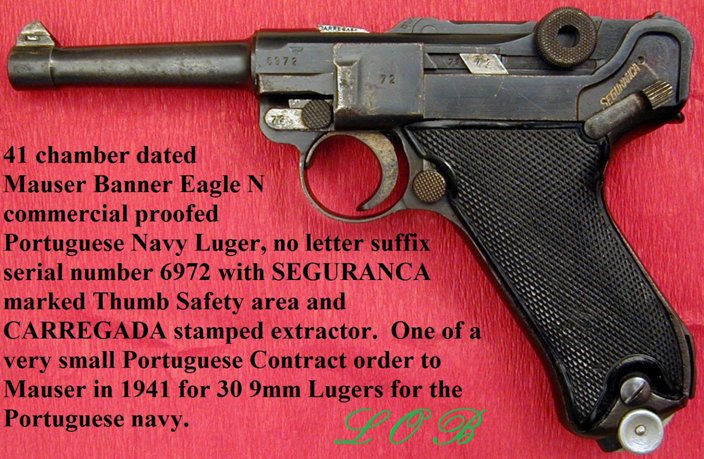
SEGURANCA is stamped in the upper frame thumb safety area and the extractor is stamped Carregada in the same large font size and style as the 1906/35 Portuguese navy. However, the last two digits of the serial number are not stamped on the extractor top surface as on the subject 1906/35 Mauser Banner grip safety Portuguese Navy Luger extractor. These small batches of guns are claimed to be in the w suffix range. The w, like all Luger serial number suffix characters is usually very stylized and is located on the front of the frame, below the 6972 serial number and in this case is very difficult to discern. The w suffix character of 41 chamber dated Mauser Banner Portuguese Navy Luger serial number 6953 is much clearer, yet also difficult to identify as a w. Pictured are two other examples for comparison being: frame serial number 3954 m and 6119 w.
It would appear that the Mauser practice of stamping the last 2 digits of the serial number on the top of the extractor seems to be more common to the 41, 42 byf military coded Mauser Lugers, whereas with the 41, 42 chamber dated Mauser Banner Eagle N proofed commercials, the extractor top surface serial number stamping, or the lack thereof, varies from gun to gun. According to Jan Still in Third Reich Lugers on page 243, Figure 48a caption states: Very few Mauser Banner Lugers bear two digit 41 or 42 dates over their chamber. These guns are pictured with and without the extractor externally stamped with the last two digits of the serial number. In the case of the 41 chamber dated Mauser Banner Portuguese Navy small-batch contract Lugers, the Carregada stamped extractors may or may not externally stamped with the last two digits of the serial number. There are, at least, two identified Mauser Banner 41 chamber dated Portuguese navy Lugers without the last two digits of the serial number stamped on top of the Carregada stamped extractor.
The Eagle N commercial proofs of 6972 are located on the receiver left side and breechblock and on the front surface of the barrel integral sight block. This extremely rare Portuguese Navy Luger is believed to be one of only six that have been identified of a very small (30-gun) contract.6 This particular Portuguese Navy Luger variation is not pictured or discussed in any Luger publication to date. John Walters in The Luger Book on page 232 gets very close to specifically identifying this variation where he states under the caption when discussing the Mauser 1935 Portuguese GNR contract: The authenticated acquisitions are: October 1941: 30 pistols, numbers unknown.
The first thought that comes to mind of this very small contract is that It is particularly amazing that Mauser, in the peak of production, to meet intense demand for weapons during the Wehrmacht build-up and the June 1941 invasion of the Soviet Union would have the time or inclination to bother with such a small foreign order contract. However, it turns out that Mauser was not at the peak of production in 1941 and that the real production peak for all German war manufacture occurred in 1944. Production output therefore, had nothing to do with the Mauser/Portuguese relationship and one has to look elsewhere for answers, probably political.
The configuration of the fourth pistol variant, vaguely referred to in current publications, is not specifically identified as a Portuguese Navy Luger variation, and is generally referred to in THIRD REICH LUGERS and Their Accessories by Jan C. Still, © 1988 on pages 219 and 220, under the category of: MAUSER COMMERCIAL LUGERS as one of ten variations, being Variation 10, Two Digit Date: Dated 41 or 42, caliber 7.65 or 9mm 4-inch barrel, C/U or E/N or no proofs; small parts strawed or blued; black plastic or wooden grips; some have P.08 on frame; reported in 7730w-9747w 600y-11y, and 8126y-9194y serial range. Those without proofs were likely late war assembly. Still also states: An important portion of those produced during the war (particularly Variation 10) may have been intended for German military self-purchase.
The 41 chamber dated Mauser Banner P.08 style Portuguese navy Luger 6972 "w" suffix serial number is in the listed serial number range and therefore not all guns in this range were intended for German military self-purchase.
There is mention of a 42-chamber dated Mauser Banner commercial as being a Portuguese Navy contract Luger which has been identified as serial number 8024y, being located in the 1997 FGS, Inc. batch of 367 Lugers acquired from the Lisbon Navy arsenal. However, the frame thumb safety area is stamped Gesichert and the extractor is stamped Geladen. The claim of being one of a small 19 (42) contract order of Portuguese Navy Lugers is tenuous, as no contract has been specifically identified.
Mystery Portuguese Navy "Reject" Luger Holster
The following is a description of a very unusual Portuguese Navy holster for a 120mm 30 cal barrel Luger with a permanently attached shoulder strap sewn to the back of the holster. On the strap is a sliding or removable twin magazine pouch. The holster is defined as a Portuguese Navy holster because it was one of about twenty identical holsters acquired in 1997 directly from the Portuguese Navy Arsenal or depot in Lisbon, through an intermediary7, by F.G.S. Inc., a major Luger dealer and collector, at the same time, along with a 367 mix of Mo.9438 and Portuguese Navy Lugers. The holster has been in the possession of F.G.S. Inc. until recent times. Possibly a Manuel II or M2 chamber crested Luger pistol was holstered, but this is undetermined at this time. Except for its longer length, the holster is identically configured/constructed as the DWM provided 1906 Mo.910, 100 mm barreled 9mm Portuguese Navy holsters, with the shoulder strap permanently attached to the holster body by stitching.
The difficulty in defining the use or intended use of this holster is confounded by the twin magazine pouch, which is too short for a Luger magazine. The twin magazine pouch is similar in style and construction to the Imperial German Navy twin magazine pouch, except it is shorter. The twin magazine pouch, ironically, has the semi-circular cut-outs at the body entrance for a Luger magazine wooden bottom. In addition to the attached leather pouch on the holster spine for a Luger cleaning rod, under the holster flap, there is a pouch for a Luger loading tool. There is no Portuguese A.E. inspection mark or any marks whatsoever on this holster, nor on the permanently affixed shoulder strap.
An additional manufacturing anomaly is encountered when inserting a cleaning rod into the spine attached, 196 mm long, cleaning rod pouch. One cannot close the cleaning rod pouch flap, i.e. it is dimensionally impossible to pull the pouch flap slit over the brass stud. For whatever reason, the entrance to the pouch sits approximately 4 mm higher than a standard M2 holster cleaning rod pouch. Combined with the fact that the brass stud is attached 7 mm lower than a standard M2 and the flap is 4 mm shorter, an insurmountable situation is created.
The wear seen on this holster is restricted to a significant loss of the surface epidermis layer and is the result of poor arsenal storage over a long term, possibly in excess of 75 years. The holster is otherwise perfectly intact with no loose stitching, tears or any evidence of ever having been used to house a Luger.
The subject holster twin magazine pouch could be an accident of construction. However, as of this writing, there are at least twenty of these specific holster configurations identified. If the magazine pouch is a leather maker’s mistake, then the short, twin magazine pouch could have been simply removed from the shoulder strap and replaced with a proper length pouch. But all the identified holsters still sport the original magazine pouch, supporting the thought that the twin magazine pouch and the holster were deliberately manufactured by (DWM) to house a 120 mm barrel, 30 Cal., Portuguese (Navy) Luger. Twenty of these peculiar 120 mm barrel-style Portuguese Navy Luger holsters were found in the Lisbon Navy arsenal, along with 247 Portuguese Navy Lugers, mostly the 1910, 100 mm barrel model. However, not one single four inch, 9mm barrel example of the holster, with the proper length twin magazine pouch, made specifically by DWM for the Mo.910 9mm Luger, was found in the arsenal.
It has been suggested, although not verified, by one major collector that the Portuguese Navy may have used some M2 Lugers with holsters in the mid 1930s, identical to the subject holster, while they were waiting for delivery of a small batch of 1935/06 Mauser Banner grip safety Lugers with Carregada marked extractors and Seguranca marked thumb safety recesses.
There is another one of these exact holsters advertised, however not accurately described, as an "Unidentified Commercial Holster".
The Manuel II or M2 holster variants
There are at least six variants of the M-2 holsters, again identified as variations in the article for clarification only and do not represent any particular order. The M-2 holster is the most common of the Portuguese holsters with 5000 made for the 5000 contract M-2 120mm barrel, 30 cal, grip safety, new model Luger order of the Portuguese Army in 1909.
The first variation M-2 holster is the most frequently encountered with a tear drop style holster flap edge. The holster has provisions for a loading tool under the holster flap and a pin punch and a cleaning rod with compartments attached to the holster body spine. On the rear is a rather wide, single belt loop, attached at a slight angle by stitching. Since these holsters were issued by the Portuguese Army arsenal or Arsenal do Exercito (A.E), most of this variation is inventory stamped with the A.E, either on the rear to the right of the belt loop or on the inside back wall of the holster body, curiously without the period after the E. Another peculiarity of this holster is a small rectangular, 4 mm deep cut-out, located inside the holster body. The cut-out is in the inside rear wall of the first layer of the doubled layered construction, apparently for a perceived clearance issue of the left side square face toggle knob or the most probable reason is precisely because of the rather 4mm thick lip or edge of the holster backing caught the left forward edge of the new model square corner toggle knob during insertion of the pistol, as an M-2 Parabellum will comfortably fit in this holster, with or without the holster backing square cut-out. Safety is the most important reason for the cut-out, or more precisely, it is a recess or cavity for the Thumb Safety lever of which when an M2 Luger is fully seated in the holster the toggle knob is past the recess and it is the Thumb Safety lever which occupies the cut-out or recess. This allows the Thumb Safety lever to rest undisturbed, hopefully in the upper safe position, by the jostling of the pistol while in the holster and also allows for the insertion and removal of the pistol with no holster contact with the Thumb Safety lever. This recess cut-out was an afterthought, apparently not done at the time of manufacture, but after receipt by the arsenal. There is a pistol pull-up strap on the front of the holster secured at the other end on the back wall to the right of the rectangular toggle knob cut-out.
The second variation is constructed of special leather with a pebble grain type pattern on the front, including the holster body and rounded edge flap. The flap edge, instead of border piping, has a full piece of leather materiel sewn completely around the edge, including the holster body entrance edge or lip. The inside of the holster flap is of the same pebble grain material except being tan or light brown in appearance while the two layered inside and back side of the holster rear wall is finished with a tan or brown color standard leather. The holster is otherwise identical to the first variation with the same tool provisions. This variation can also have the A.E stamp located on the front interior wall or back side.
The third variation is similar to the GNR variations 1 and 2 constructed of sturdy black dyed leather with the rounded holster lower flap edge. The differences being it lacks the interior wall toggle knob clearance cut-out and there is no Army arsenal A.E stamp.
The fourth variation is seldom seen but is identical to the second variation but with a very narrow belt loop sewn to the rear in the same location and the front the holster lacks a compartment for a pin punch. There is also another fifth variation, also with a narrow belt loop and without a pin punch compartment, all black holster, similar to the most common first variation.
It is the fifth variation that is basically unknown to collectors but is similar in pattern and style to the most common first variation. However, the holster lacks a pin pouch on the front, is without the interior holster body wall cut-out and there is no Army arsenal A.E stamp. The holster has a narrow, later added, 35 mm wide belt loop sewn to the rear whereas the first variation has the typical 53 mm wide belt loop. In this variation the lack of a pin pouch compartment is correct, as it is not a requirement per navy regulation.
There is only one published reference to these M2 navy Luger holsters in Luger Holsters and Their Accessories on page 434. When describing the "M-2" Model Holster for the 1906 Luger Pistol, Bender comes close to identifying this navy variation where he states: A separate contract for 1000 9mm pistols (actually the initial 1909 dated contract, as stated earlier was for 350 pistols) was awarded DWM by the Royal Portuguese Navy and it is possible that some modified holsters of the example pictured above found their way into that branch of service. The Bender holster pictures are basically the most common M2 army configuration with the final 53mm wide belt loop, both with a pin punch and cleaning rod pouch on the front, and with the A.E arsenal added toggle knob clearance cut-out and subsequent A.E arsenal stamp. It is unusual that Bender, obviously aware of "modified" M2 army holsters for the navy, does not go any further in his description for the purpose or reason for these holsters.
As it turns out, contrary to Benders description of "modified" M2 army holsters for the navy, this holster did not start out its life as a Manuel II or M2 army holster. Originally it was made for the Portuguese navy, who borrowed or transferred about a hundred model 1906 Portuguese Army M2 Lugers (which have no add navy marks, but could have the navy MP inventory stamp on the receiver left side) while they waited for their first batch contract delivery of the M1909 9mm Royal Crown over Fouled Anchor chamber crested Lugers from DWM, sometime in early 1910. The narrower 35 mm wide belt loop was added later as the holster, as originally configured, had a shoulder strap affixed, which was preferred by the navy rather than a belt loop. This is clearly evident by the two sets of parallel stitching lines on each side of the back side of the holster.
The original shoulder straps were later, very professionally removed, i.e. having been cut off, simply by shearing the stitching with a sharp knife, between the strap and the back wall of the holster. The remnants of the threads were left in the holster to fill the stitching holes - they may have been waxed or varnished to retain them. The subject holster, although not A.E arsenal inventory stamped, does have a large 12 mm high, deep, widely spaced (21mm) stamping, two digit number 2 1. The stamp is unusually located or stamped on the inside of the holster backing under the flap. It is most likely an inventory number applied by the Portuguese navy. No regular M2 army holster has ever been noted with any similarly located number stampings.
As to who did the professional conversion (possibly depot) basically back to an M2 army configuration, or why, is not known. Whether the holster was returned to the Portuguese army inventory is also not known. The leather affixed shoulder strap, though, was rather short lived as other than the remnants of being sewn to the holster rear, the area covered by the straps is equally aged and similar in coloration to the surrounding area whereas the color of the added belt loop, although attached at the proper angle and position to the standard M2 army holster belt loop, is different in color from the surrounding leather. Also, the size of the threads and stitching pattern is different from the standard 53 mm wide M2 belt loop.
Despite the short time in the Portuguese navy inventory, the holster, although in good condition externally, does show evidence of long term M2 storage. There is a permanent impression of the Thumb Safety lever grasping surface in the holster. However, the holster does not show long term usage of being carried on a belt due to minimal scuffing of the external surface of the belt loop against any materiel or fabric that is generally seen on many standard army M2 holster belt loops.
Additional information of the navy M2 variation holster comes from a major European Luger expert, collector and author. He supports the existence of a stand-alone Portuguese navy M2 holster. He quotes from Portuguese sources (retired navy senior officers and officials of the Portuguese navy museum) from the 1990s that a navy variation M2 holster, albeit a small number, did/does exist as evidenced by surviving M2 holsters with navy pattern shoulder straps.
Apparently the navy made an earlier attempt to procure a small number of holsters of the M2 120 mm barrel type 30 cal Lugers, acquired from the army. However, the drawings provided to the leather maker were apparently misread, resulting in the Mystery Portuguese Navy Reject "M2" holster with a too short twin magazine pouch, discussed earlier. The maker appears to have had copies of the Army M2 holster made with their preferred shoulder strap rather than a belt loop - hence the anomalous holsters with shoulder straps that seem to have been the first attempt that was dimensionally wrong, and then the ones like the featured fifth variation with the shoulder strap, which the subject holster looks like one of the Navy made M2 holsters. Although they were also made per navy regulation, as the anomalous holsters were probably intended to be, also correctly without the pin punch compartment, but properly made to correct dimensions per navy regulation and of better quality cowhide, which were made up by/for the Navy (hence no A.E mark).
There is another M2 style Portuguese navy shoulder strap holster shown with a full length twin magazine pouch. However, the magazine pouch looks to be a production replacement pouch as this holster, as originally made had a short twin magazine pouch, too short to hold a full length Luger magazine. Despite its convincing appearance as a different or final accepted navy M2 version, this holster is certain to be one of the holsters that is identical to the ones found in the Lisbon arsenal due to the following characteristics and features:
- The brass studs of the holster body, the cleaning rod pouch and the loading tool pouch are of the same shape and style, with evidence of circular machining lines on the stud surfaces with a definite pointed termination at the top center of the stud (s) of the rejected holsters.
- Secondly, the entrance lip of the cleaning rod pouch, the normally vertical cut has clearly been modified by cutting back the forward edge of the pouch downward to create a slope, allowing the cleaning rod pouch to seat further down, thereby allowing the flap to close with a barrel top cleaning rod inserted. The slope is accentuated even more when noting the location of the cleaning rod pouch upper attachment points to the holster spine or entrance, which are at the same position dimensionally as the pictured Mystery reject navy holster vs. the lower attachment position of the typical M2.
- The cleaning rod pouch brass studs of both holsters, reject and typical M2, are basically, dimensionally positioned or located on the pouch, however it is the solely higher height of the "reject" holster cleaning rod lip that doesn’t allow the flap to completely close. By removing some of the leather at the entrance, thereby creating a downward angle slope solves the problem.
As to who did this alteration is not known, however if done by the Portuguese navy authorities, it is the sole example of one of the Mystery navy reject holsters being put into service.
It is the variation 5 holster which was described earlier with the original shoulder straps removed that is the more logical configuration (until disproved) used by the navy for its M2 Lugers with regulation shoulder straps, yet without a pin punch pouch, never a navy requirement, and as such these holsters would not be “officially” accepted by the army, even if they were later reworked back to the army M2 configuration, which is highly unlikely as the Portuguese army had all the M2 holsters it needed, (even assuming the navy returned the army M2 Lugers), properly configured with the added army regulation required pin punch pouches, that one may never locate an original M2 navy shoulder strap holster configuration.
There is a sixth variation of the Portuguese M2 army holster, which at first glance, the front of the holster with the flap closed looks like the typical dyed black M2 holster with the tear drop style cover flap, with pouches for a pin punch and cleaning rod. The first clue that this holster is different is the white metal appearance of the holster body stud vs. the typical brass stud. The stud looks to be aluminum but is steel. With the cover flap open reveals other significant differences, the first being the double wall holster body leather backing which is light brown or tan in appearance with a cut-out for the left side toggle knob, similar to version 1.
The second major observation or difference is the shape of the holster body entrance contour which is much higher with a shallower dip or edge contour than the typical M2 army holster, which with an M2 Luger fully inserted, covers most of the gun. As a result of the higher and shallower lip the pull-up strap, which is the third major difference, which is 18 mm wide, much wider and subsequently stronger than the typical M2 pull strap length of 10mm, is positioned higher on the holster body. Also, interestingly, the wider pull-up strap is installed with the finished side of the leather reverse that of the typical narrower pull-up strap. The rear of the holster also departs from the typical M2 holster with the same light brown or tan smooth cowhide leather as the inside wall with a very wide 56 mm angled single belt loop. There is no A.E Portuguese arsenal inventory stamp on this holster, however the inside back wall of the holster body has the typical arsenal rectangular cut-out for the left side toggle knob and Thumb Safety lever clearance. The holster does not appear to have been altered or repaired as the first inclination is to suspect the originality of the holster body steel stud. The steel stud is original to the holster as the rather large 20 mm diameter circular thread stitching pattern around the stud, vs. the typical brass stud rather tight 16mm diameter circular stitching, both the typical M2 and the subject variation 6, being stitched though the thicker holster body leather and through an inside corresponding circular piece of thin leather that holds the stud in place on variation 6, is undisturbed, as is the surrounding leather.
The GNR holster Variations
As of this writing there are at least three known GNR Luger holsters variations, identified as Variation 1, Variation 2, and Variation 3 with Variations 2 and 3 part of the LOB collection. The term variation or configuration is used in this document for identification purposes only and does not necessarily represent any chronological order of manufacture. All three GNR holster variations were manufactured in Portugal for the 564 contract order of the 1906/35 Mauser Banner grip safety, 120 mm barrel, 30 Cal Luger for the Guarde Nacional Republicana or GNR. The three variations are pictured below:
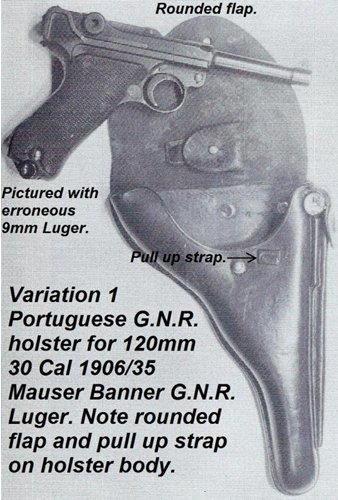
|
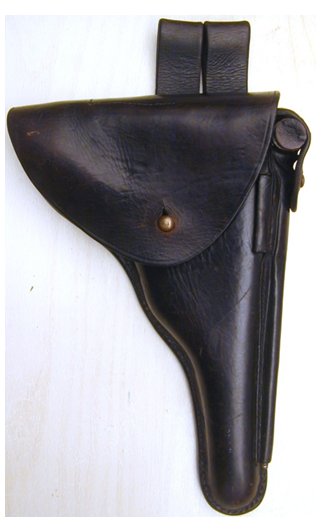
|
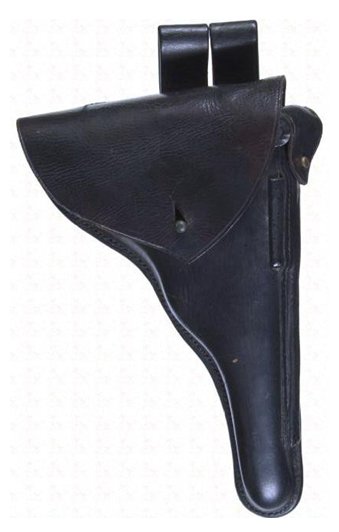
|
| Variation 1 | Front Variation 2 Back | Front Variation 3 Back |
| Inside | Inside | |
| Click on front, inside or back to see indicated side of holster. | ||
First described are the similarities. All three variations have the unique elongated split belt loop that extends above the top of the holster, attached to the holster rear by four steel rivets. All three variations have a pouch under the holster flap for a loading tool, a pin punch and a cleaning rod, both on the holster body spine. All three variations are very lightly stamped, barely readable on the rear holster body, to the right of the belt loop with the widly spaced letters G N R with the letter G apparently stamped under the belt loop. The date (1) 936, probably representing the date of manufacture or issue is also stamped on the holster body below the GNR. The number one (1) of the 1936 is stamped very close to the right lower edge of the belt loop indicating that the GNR and date were stamped prior to attaching the belt loop. Stamped on the lower section of the belt loop are some unidentifiable numbers and characters, probably some form of identification with 2 two characters, left to right with the first being a 4 and the second being an F or E. These identical characters are located on all three variations. The final, larger set of characters are also located on the belt loop below the 4(F) (E) and are different for each GNR holster made, regardless of variation and probably represent a unit assignment or inventory number. Variation 2 is stamped 181 with the third digit 1 being stamped over a zero (0) and Variation 3 being stamped 25.
The differences are distinct. Starting with Variation 19 of which only a frontal picture is available, yet the differences are clearly visible. The first being the holster flap, the loading tool flap and the loading tool flap lower edge terminations being rounded. Also note that the Variation 1 holster body has a pistol pull-up strap.
Variation 2 is basically identical to Variation 1 with one significant difference, or in this case, the absence of a holster body pistol pull-up strap. The strap was never installed, no slit in the holster body nor any internal rear holster body wall pull-up strap connection.
Variation 3 is unique from both Variations 1 and 2 as the holster flap and loading tool flap lower edge terminations are in the shape of a tear drop, similar to the Manuel II or M-2 Portuguese Army holsters. Also the style and size of the loading tool pouch, located on the underside of the holster flaps of Variations 1 and 2 are identical, but are different from Variation 3. Both Variations 1 and 3 have a holster body pistol pull-up strap. The most significant difference between the three variations are the style, size and diameter of brass studs used for both the holster body and cleaning rod pouches, of which Variations 1 and 2 are identical, but with Variation 3 having a completely different shape, size and diameter of brass stud as compared to Variations 1 and 2. The differences in the brass studs in conjunction to the different style flap terminations and different style and size of loading tool pouches, suggests, at least, two different Portuguese holster makers or suppliers. The lack of a holster body pistol pull-up strap on Variation 2 of the basically identical Variations 1 and 2 could be attributed to a simple omission. Since the basic holster style and the stitching patterns are identical, this assumes then that the basic holster drawings or standards were provided to different Portuguese holster manufactures. The differences noted were probably a result of slightly different, minor style approaches between vendors and in the case of the brass fittings, different suppliers.
1909 Mo.909 Portuguese contract M2 Twin Magazine Pouch
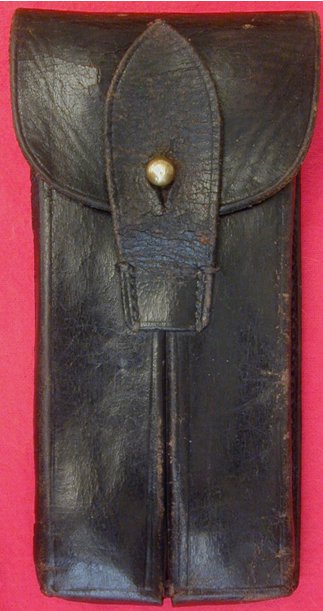
|
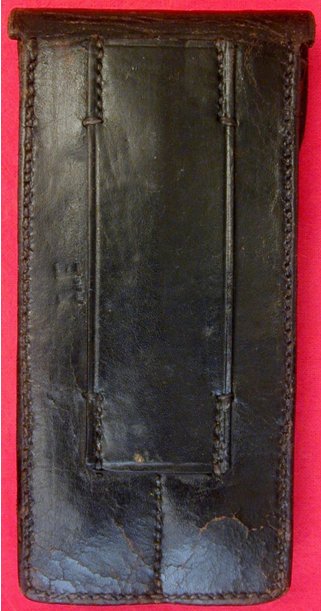
|
| Front | Back Side |
Pictured above is a typical black dyed twin magazine leather pouch, showing long term magazine storage, for the Mo.909 Portuguese Manuel II or M2 Luger. Note the A.E stamped on the rear for Arsenal do Exercito. This A.E stamp can also be located on the inside of the cover flap. Portuguese M2 twin magazine pouches have also been observed with A.E and the year 1909 ink stamped on the inside of the cover flap. Interestingly the pictured M2 twin magazine pouch came with a pin punch inserted in between the two attached leather pouch compartments under the cover flap. This is a non-regulation storage location as there is a provision for a pin punch compartment on the front of standard M2 holsters.
For a manufacturing time difference of approximately 26 years, the Mo.909 M2 pouch is remarkably similar to the Mo.935 Portuguese GNR twin magazine leather pouch, except for the obvious different markings. Described are the minor differences in construction. Side-by-side with the M2, the GNR pouch appears slightly larger, due mostly to its more rugged construction, using heavier leather with a cover flap wall thickness of 3.78 mm typical vs. a typical cover flap wall thickness of 2.30mm for the M2 pouch. The use of different leather thicknesses results in a slightly larger in appearance, heavier weight GNR pouch (less magazines) of 118 grams vs. 68 grams for an empty M2 pouch.
The width of the rear belt loops of both the M2 and GNR magazine pouches are the same 39mm, however, the thicker GNR belt loop is 122mm in length vs. 110mm for the thinner M2 belt loop. The strap that secures the cover flap of both the M2 and GNR are mostly identical except the two vertical lines of stitching securing the strap to the body for the M2 are not parallel, being angled or narrower at the bottom, whereas the GNR stitching is parallel. The brass studs are also of different shape and size.
1936 Mo.935 Portuguese contract GNR Twin Magazine Pouch
There are several variations of the 1936 contract Portuguese GNR twin magazine pouch and all are quite scarce and seldom offered for sale. Scarce because of the limited number of contract GNR pistols and also because, in the case of the magazine pouches, were not replaced when lost or destroyed.
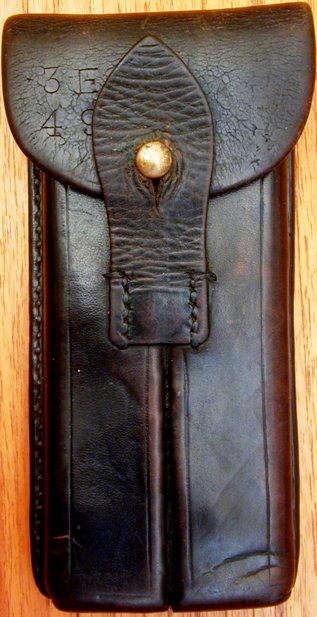
|
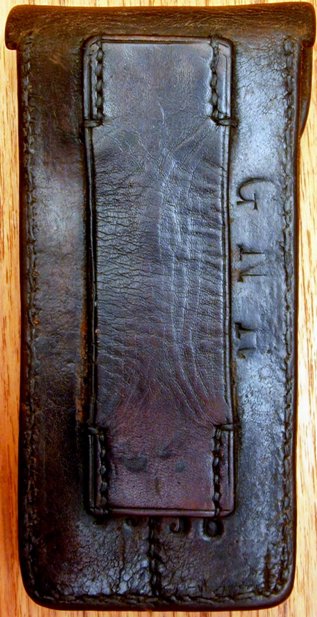
|
| Front | Back Side |
Pictured above is one of the most representative examples of the 1936 Mo.935 Portuguese contract GNR Twin Magazine Pouch. It shows long term magazine storage and with the most desirable features or markings to the collector, not seen on most observed Portuguese GNR twin magazine pouches, being a date and contract identifier stamped on the rear. As stated earlier the pouch is extremely rugged, being made of very thick leather. On the rear of the pouch is a 1936 manufacturing date stamp along with a GNR stamp. The cover flap has some additional unidentified characters, 3E and 49, similar to those found on the rear of the two featured GNR holsters, whose purpose is also not known. In addition there is a single digit 8 stamped on the cover flap, hidden by the holster body closing strap. Since the 1936 stamping on the back side is partially covered by the twin magazine pouch belt loop suggests it was stamped on the leather before the belt loop was sewn to the magazine body. The twin magazine pouch GNR stamping is completely visible, however, there are examples where the GNR is partially obscured by the belt loop. This indicates that the 1936 and the GNR stampings were not only applied before the attachment of the belt loop of both the holster and magazine pouch, but before the leather materiel was shaped to make the holsters and pouches by the Portuguese Saddlers.
This would explain why some of the same style magazine pouches can be found with and without a date stamp or, with the GNR but without the date, as a result of the arbitrary stampings of the date and GNR. The probable reason for the stampings in the first place was to identify the contract date and identification. The first number of the 1936 date stamp found on the two featured GNR holsters is also partially covered by the holster belt loop, suggesting the same scenario for the holsters being made by the same Portuguese contractor or Saddler. Pictured are three GNR examples: Example 1 LOB collection, example 2 back side file copy, example 3 file copy.
The Cleaning Rods
Interestingly, both Variations 2 and 3 LOB holsters came with almost identical, original cleaning rods. Possibly of Portuguese manufacture, the cleaning rods are of all steel construction; barrel handle and removable cleaning rod shaft. These cleaning rods are different from the early DWM cleaning rods which were finished much nicer with brass shafts and have a completely different styled knurling pattern on the screw cap, cross hatching for the DWM style cleaning rod vs. single angled striations for the Portuguese cleaning rods. The Portuguese cleaning rods are unique inasmuch as on the end of each barrel handle, opposite end of the barrel or handle of the removable knurled cap with attachable grease spade, is stamped with identical manufacturing inspection marks. There is no doubt that these cleaning rods were made by the same manufacturer, yet curiously have different style serrated tips. Sam Costanzo in World of Lugers, Volume I, 1977, discusses these particular cleaning rods at length: The letters kk within a circle are noted, as well as the numbers 19 and 5 in individual circles. These proofs have been noted on magazine bodies also. These particular proofs are noted on several GNR cleaning rod grease compartments. These particular cleaning rods differ in construction, size (diameter), and manufacture from the DWM produced rods for commercial and contract sales; even the M-2 variation used by Portugal earlier. Whether Mauser produced these cleaning rods for the GNR series is not known, as so few are known at present. It is doubtful that they did, because NO Mauser proof or number is present; while the 18 or 5 in a circle is stamped on the bottom of the grease well. It is conjecture at this point, so check your cleaning rods.
It is interesting to note that in the book Lugers at Random10, Kenyon shows a GNR holster rig with twin magazine pouch, cleaning rod and loading tool with the caption excerpt: Back of the holster stamped "1935." Back of magazine pouch stamped "1935." This infers that the GNR holsters and twin magazine pouches were manufactured in 1935 and 1936, or at a minimum, all made in 1935 and issued in 1935 and 1936. The cleaning rod shown as part of the GNR rig appears to be of the early DWM style with crossed hatched striations on the cleaning rod barrel removable cap and the rod or shaft appears to be brass.
 Home page
Home page


